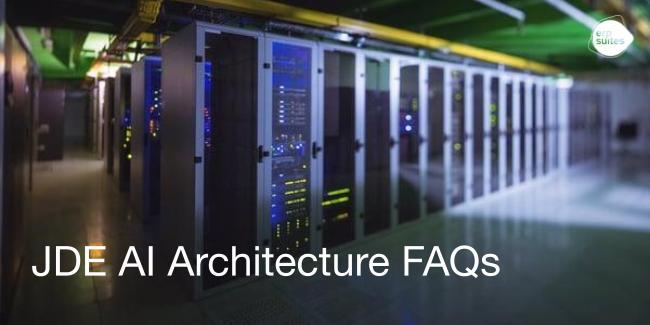.png?width=960&height=540&name=Blog%20Images%20(50).png)
Choosing the right ERP (Enterprise Resource Planning) system for your business can feel like a daunting task. You’re probably overwhelmed with the sheer number of options, the technical jargon, and the potential impact on your company’s future. You’re not alone. Many business owners, IT leaders, and decision-makers feel the same way. The pressure to choose the right system that can streamline operations, improve efficiency, and support growth is immense.
At ERP Suites, we understand this challenge deeply. We’ve seen companies thrive with the right ERP system, and we’ve also seen the struggles that come with a poor fit. Selecting a new ERP system or deciding to replace an existing one can be a daunting task, and we help our customers select the best ERP for their given business. In this article, we’ll provide a thorough comparison of two major ERP systems: Oracle JD Edwards (JDE) and SAP. Our goal is to inform and educate you so you can make the best decision for your business.
By the end of this article, you’ll have a clear understanding of the strengths and weaknesses of both JDE and SAP in the following categories:
- Industry focus
- Supply chain
- Manufacturing
- Financial management
- Inventory management
- Cost
- Agility
- Technology
Target Markets and Industry Focus
One of the most significant differences between JDE and SAP is their target markets and industry focus.
JDE's Targeted Industries and Their Needs
JD Edwards has strategically chosen to focus on a modest set of industries where it can excel. These include manufacturing, consumer packaged goods, and other asset-intensive industries, like oil and gas, pulp and paper, and metals/foundries. By specializing in these areas, JDE can offer deep functionality and tailored solutions that meet the specific needs of its customers.
For instance, JDE’s strong capabilities in managing the entire lifecycle of crops make it a preferred choice for agribusinesses.
SAP's Broad Market Reach and Diverse Industry Solutions
SAP, on the other hand, aims to be a one-size-fits-all solution. Its ERP systems are designed to cater to a wide range of industries, from finance and insurance to manufacturing and retail. This broad approach means that SAP offers extensive functionality, but it also means that the system can be more complex and harder to implement.
Effectiveness of JDE and SAP in Various Industries
While SAP’s broad approach makes it suitable for many industries, JDE’s focused approach means that it can offer deeper, more tailored functionality in its chosen industries. For businesses within JDE’s target markets, this specialized focus can result in more effective and efficient operations.
Supply Chain Management
Supply chain management is the backbone of many businesses, ensuring that products move smoothly from suppliers to customers. JD Edwards and SAP offer robust solutions, but they cater to different needs and industries.
JDE's Approach to Supply Chain Management
JD Edwards has built its reputation by focusing on specific industries such as manufacturing, consumer packaged goods (CPGs), and asset-intensive industries. JDE's supply chain modules are designed to handle complex processes efficiently, making it an excellent choice for companies that need precise control over their supply chain operations.
For example, JDE’s capabilities in managing procurement processes and subcontractor models are particularly strong, which is essential for engineering and construction companies.
SAP's Supply Chain Capabilities
On the other hand, SAP provides a comprehensive suite of supply chain solutions that cater to a wide range of industries. SAP's advanced planning and optimization tools are unparalleled, offering businesses detailed insights and control over their entire supply chain.
However, for some, this extensive functionality can sometimes be overwhelming and more than what smaller companies need.
Comparative Analysis
When comparing JDE and SAP in supply chain management, it’s clear that SAP has more extensive features. However, JDE’s targeted approach means that it provides just what is needed for its core industries without unnecessary complexity. If your business is within JDE’s focus areas, you might find JDE’s solutions more tailored and easier to implement.
Manufacturing
Manufacturing is another critical area where ERP systems play a vital role. Both JD Edwards and SAP offer strong manufacturing solutions, but they serve different needs.
JDE’s Focus on Manufacturing Industries
JD Edwards excels in manufacturing by providing features that cater specifically to the needs of this industry. For instance, JDE's blend management module is a standout feature for companies in the winemaking industry. This module helps manage the blending process, ensuring consistency and quality across the life cycle of the product and in the final product itself.
SAP’s Comprehensive Manufacturing Solutions
SAP, with its extensive resources, offers a more generalized solution that can be customized to fit various manufacturing needs. SAP’s solutions are designed to cater to businesses of all sizes, from small manufacturers to large enterprises. However, this flexibility comes with increased complexity and cost.
Key Differences and Strengths
While SAP’s manufacturing solutions are more versatile, JDE’s targeted approach means that it can offer deeper functionality in specific areas. For example, JDE’s capabilities in managing the entire lifecycle of crops and fields make it a preferred choice for agribusinesses.
Financial Management
Financial management is at the heart of any ERP system. It ensures that businesses can manage their finances efficiently, comply with regulations, and make informed decisions.
JD Edwards Financial Management
JD Edwards offers robust financial management tools that are designed to meet the needs of its core industries. JDE's financial modules are known for their ease of use and efficiency, allowing businesses to manage their finances with minimal overhead. This simplicity translates into lower operational costs and easier maintenance.
SAP Financial Management
SAP is renowned for its comprehensive financial management capabilities. It offers a wide range of features that can handle the financial needs of any business, regardless of size or industry. However, the extensive functionality of SAP’s financial modules often requires a larger team to manage, adding to the overall cost.
Cost Efficiency and Functionality Comparison
In terms of cost efficiency, JDE often comes out ahead, especially for smaller companies or those in specific industries. SAP’s financial management tools are powerful but can be overkill for companies that don’t need all the bells and whistles.
Inventory Management
Efficient inventory management is crucial for minimizing costs and meeting customer demand. Both JDE and SAP offer strong inventory management solutions, but there are key differences.
JDE's Inventory Management System
JD Edwards provides a robust inventory management system that is well-suited for its target industries. JDE’s system offers detailed tracking and control, helping businesses manage their inventory effectively. For example, JDE’s capabilities in managing procurement processes are particularly strong, which is essential for companies with complex supply chains.
SAP's Inventory Management Features
SAP’s inventory management solutions are part of its broader supply chain management suite. These tools are designed to handle the needs of large, complex businesses with extensive inventory requirements. SAP’s advanced analytics and automation capabilities are unmatched, but they come at a higher cost and complexity.
Comparative Analysis of Inventory Tracking and Control
When comparing JDE and SAP in inventory management, the key difference lies in the complexity and cost. JDE offers a more straightforward, cost-effective solution for its target industries, while SAP provides a comprehensive, albeit more complex, solution for larger businesses.
Cost Analysis
Cost is a critical factor when choosing an ERP system. Both the direct and indirect costs of implementing and running the system must be considered.
Direct and Indirect Costs of Implementing JDE vs. SAP
JD Edwards is known for its cost efficiency, especially for smaller companies or those in its target industries. The direct costs of licensing and maintenance are generally lower for JDE than for SAP. Additionally, the indirect costs, such as the need for fewer staff to manage the system, make JDE a more cost-effective choice.
Total Cost of Ownership for JDE and SAP
SAP’s extensive functionality requires more resources to implement and maintain. In contrast, JDE’s simpler, more focused approach results in lower overall costs. This includes both direct costs, such as licensing and maintenance, and indirect costs, such as staffing. For businesses that don’t need SAP’s extensive functionality, JDE offers a more cost-effective solution.
Agility and Flexibility
In today’s fast-paced business environment, agility and flexibility are crucial for staying competitive. Both JDE and SAP offer flexible solutions, but there are key differences.
JDE's Flexibility and Adaptability to Business Changes
JD Edwards is known for its flexibility and adaptability. The system is designed to evolve with the business, making it a great choice for companies that need to pivot quickly. For example, KIND, a leading snack company, chose JDE for its ability to adapt to changing business needs.
SAP's Approach to Flexibility in Business Operations
SAP also offers flexible solutions, but its extensive functionality can make it more challenging to adapt quickly. The system is designed to cater to a wide range of industries, which means it can be less nimble than JDE in some situations.
Case Studies: KIND and Cargill
KIND’s choice of JDE highlights the system’s flexibility and adaptability. In contrast, Cargill, a global food corporation, uses SAP for its extensive functionality and broad industry capabilities. These case studies illustrate the different strengths of JDE and SAP in terms of flexibility and adaptability.
Technology and Integration
Technology and integration capabilities are crucial factors in choosing an ERP system. Both JDE and SAP offer strong technological solutions, but there are key differences.
JDE's Orchestration and Integration Capabilities
JD Edwards stands out with its strong orchestration and integration capabilities. The system is designed to facilitate seamless integrations with other systems, making it easier for businesses to connect their various processes. This native capability is a significant differentiator for JDE.
SAP's Technological Strengths and Weaknesses
SAP also offers strong technological solutions, but its extensive functionality can make integrations more complex.
Can’t Go Wrong with Either
Both JDE and SAP have carved out niches in the ERP world that play to their strong suits and the needs of businesses in their varying markets. That being said, mid-size businesses can benefit from either – and, ultimately, the choice is up to you. As long as your ERP needs are being met, you are on the right path.
If you decide JDE is for you, we can help. Email us here and we’ll be in touch ASAP to get you started.
Leyla Shokoohe is an award-winning journalist with over a decade of experience, specializing in workplace and journalistic storytelling and marketing. As content manager at ERP Suites, she writes articles that help customers understand every step of their individual ERP journey.
Topics:



.png?width=650&height=325&name=Blog%20Images%202_1%20(4).png)
.png?width=650&height=325&name=Blog%20Images%202_1%20(5).png)
.png?width=650&height=325&name=Blog%20Images%202_1%20(3).png)
.png?width=650&height=325&name=Blog%20Images%202_1%20(2).png)
.png?width=650&height=325&name=Blog%20Images%202_1%20(1).png)
.png?width=960&height=540&name=Blog%20Images%20(96).png)

.png?width=960&height=540&name=Blog%20Images%20(90).png)
.png?width=960&height=540&name=Blog%20Images%20(88).png)
.png?width=960&height=540&name=Blog%20Images%20(87).png)
.png?width=960&height=540&name=Blog%20Images%20(86).png)
.png?width=960&height=540&name=Blog%20Images%20(85).png)
.png?width=960&height=540&name=Blog%20Images%20(83).png)
.png?width=960&height=540&name=Blog%20Images%20(82).png)
.png?width=960&height=540&name=Blog%20Images%20(80).png)